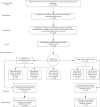Effects of a Web-based intervention for adults with chronic conditions on patient activation: online randomized controlled trial
- PMID: 22353433
- PMCID: PMC3374536
- DOI: 10.2196/jmir.1924
Effects of a Web-based intervention for adults with chronic conditions on patient activation: online randomized controlled trial
Abstract
Background: With almost one-half of Americans projected to have at least one chronic condition before 2020, a vital role of the health care system is to develop informed, engaged individuals who are effective self-managers of their health. Self-management interventions (SMIs) delivered face-to-face or by telephone (traditional SMIs) are associated with improved self-management knowledge, skills, and self-efficacy, which are expressed by the composite construct of patient activation, a predictor of health outcomes. Web-based interventions to support self-management across the spectrum of chronic diseases have the potential to reach a broader population of patients for extended periods than do traditional SMIs. However, evidence of the effectiveness of Web-based interventions on patient activation is sparse. High-quality studies featuring controlled comparisons of patients with different chronic conditions are needed to explore the interaction of Web-based interventions and patient activation.
Objective: To explore the effect of a Web-based intervention on the patient activation levels of patients with chronic health conditions, measured as attitudes toward knowledge, skills, and confidence in self-managing health.
Methods: For this 12-week study, prospective participants were selected from the patient panel of a regional health care system in the United States. The 201 eligible participants were randomly assigned to two groups. Intervention group participants had access to MyHealth Online, a patient portal featuring interactive health applications accessible via the Internet. Control participants had access to a health education website featuring various topics. Patient activation was assessed pre- and posttest using the 13-item patient activation measure. Parametric statistical models (t test, analysis of variance, analysis of covariance) were applied to draw inferences.
Results: The Web-based intervention demonstrated a positive and significant effect on the patient activation levels of participants in the intervention group. A significant difference in posttest patient activation scores was found between the two groups (F(1,123) = 4.438, P = .04, r = .196). Patients starting at the most advanced development of patient activation (stage 4) in the intervention group did not demonstrate significant change compared with participants beginning at earlier stages.
Conclusions: To our knowledge, this is the first study to measure change in patient activation when a Web-based intervention is used by patients living with different chronic conditions. Results suggest that Web-based interventions increase patient activation and have the potential to enhance the self-management capabilities of the growing population of chronically ill people. Activated patients are more likely to adhere to recommended health care practices, which in turn leads to improved health outcomes. Designing Web-based interventions to target a specific stage of patient activation may optimize their effectiveness. For Web-based interventions to reach their potential as a key component of chronic disease management, evidence is needed that this technology produces benefits for a sustained period among a diverse population.
Conflict of interest statement
None declared.
References
-
- Anderson G. Partnership for Solutions. 2004. Sep, [2012-02-06]. Chronic Conditions: Making the Case for Ongoing Care http://www.partnershipforsolutions.org/DMS/files/chronicbook2004.pdf.
-
- US Census Bureau. 2008. [2011-07-18]. National Population Projections: Projections of the Population and Components of Change for the United States: 2010-2050 http://www.census.gov/population/www/projections/summarytables.html.
-
- Bodenheimer T, Wagner EH, Grumbach K. Improving primary care for patients with chronic illness. JAMA. 2002 Oct 9;288(14):1775–9.jip21004 - PubMed
Publication types
MeSH terms
LinkOut - more resources
Full Text Sources
Medical


